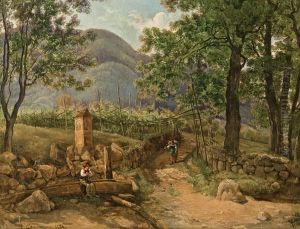Carl Gauermann Paintings
Carl Gauermann was an Austrian painter born on April 21, 1802, in Miesenbach, Lower Austria. He hailed from a family deeply ingrained in the arts; his father, Jacob Gauermann (1773–1843), was an esteemed engraver, which undeniably influenced Carl's early exposure and inclination towards art. Despite the limited resources of his rural upbringing, Gauermann's talent was evident from a young age, and his father took on the role of his first mentor, guiding him through the fundamentals of drawing and engraving.
Gauermann's style evolved significantly over the years, initially focusing on the precise and detailed work of engraving under his father's tutelage, before transitioning to painting, where he found his true calling. His works are primarily known for their meticulous attention to detail, vivid portrayal of the Austrian countryside, and the dynamic representation of animals in their natural habitat, which became his signature theme. He was particularly adept at capturing the interplay of light and shadow, imbuing his landscapes and animal scenes with a lifelike quality that was both enchanting and highly realistic.
In the 1820s, Gauermann began to gain recognition beyond his local sphere, thanks in part to his participation in exhibitions in Vienna. His works caught the attention of the Austrian aristocracy and art patrons, leading to commissions that would secure his reputation as one of the leading landscape and animal painters of his time. His painting style, characterized by its romantic realism, resonated with the burgeoning Biedermeier movement, which emphasized the beauty and simplicity of everyday life in the wake of the Napoleonic Wars.
Carl Gauermann's contributions to Austrian art were widely recognized during his lifetime, and he received numerous accolades, including an honorary membership in the Vienna Academy of Fine Arts. Despite his success, he remained deeply connected to the landscapes of his youth, often drawing inspiration from the Austrian Alps and rural life. He continued to paint until his death on June 2, 1863, in Vienna. Today, Gauermann's works are celebrated for their historical significance and artistic beauty, housed in museums and private collections across Austria and beyond. His legacy is testament to the enduring appeal of naturalistic and detailed landscape painting, marking him as a pivotal figure in the transition from classical to romantic art in the 19th century.
